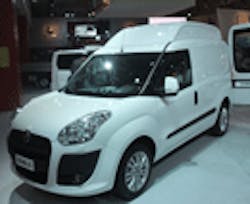Options for true commercial vehicles in the lightest Class 1 and 2 range are relatively limited in North America once you get beyond walk-in or step vans. But walk-ins, which have small, under 10,000-lb GVWs but large overall size to handle low-density, high-volume loads like bakery goods, aren’t well-suited to applications that need commercial truck durability and utility in a small package. And minivans, while popular with large families, haven’t proven to be up to commercial business demands.
But European OEMs have a long history of building small commercial vans for dense urban markets. While early vehicles like the Fiat Multipla with its 600cc air-cooled engine weren’t suitable to domestic truck buyers here, the newest generations of these under 10-ton trucks look like they might be ready to bring a whole new category of light trucks to North America.
The pioneer is Ford’s Transit Connect, a sales success since its introduction despite arriving here in the midst of a miserable economy. With a GVW of just 5,000 lbs., it offers high head room, a flat floor and maximum cargo volume in a small truck that’s at home on city and suburban streets. And an electric vehicle (EV) version has followed. Small and large service businesses, in particular, have been quick to see the advantages over the full-size pickups and vans they had been using.
But Ford is unlikely to have this emerging truck segment to itself for long. At the recent IAA Commercial Vehicle truck show in Hannover, Germany, three other manufacturers with well-established N.A. dealership networks unveiled new trucks for the under-10-ton market, and broad hints are that at least two will be headed here in the near future.
Mercedes-Benz Vans, the Daimler group that already imports the larger Sprinter family to N.A. under the Mercedes-Benz and Freightliner nameplates, had the new generation of its Vito, a 6,000- to 7000-lb. GVW commercial van on display. It also unveiled a production EV version using its E-Cell battery technology. The same technology was displayed in a Class 2 Mitsubishi Fuso Cantor concept truck , a COE model that’s been sold here for some time with standard diesel power.
While there’s no indication that Daimler intends to bring the standard Vito to the U.S. anytime soon, both MB Van and Fuso speculated that E-Cell versions of either the Vito or Cantor might be possible for the U.S.
Nissan, which is about to introduce it North America--only NV2500 large commercial van shortly, was also in Hannover with a new small CV, the NV200. Introduced last year with a small diesel, an EV version scheduled to go into production within a year was the big news at the Nissan booth.
Here in North America, Nissan officials won’t confirm that the NV200 will join the larger NV2500 in its lineup, but a spokesperson said: “We’re looking at other [Nissan global] products that might be suitable for North America, and there have been public statements made that we’d like to have [the NV200].”
In particular, the EV version of the NV200 might be headed here as Nissan has already confirmed that it will soon announce a battery-powered vehicle to join its new Leaf EV passenger car. “It certainly looks attractive for certain commercial applications, and Nissan NA is committed to having a range of electric vehicles, not just the Leaf,” the spokesman said.
As the new majority stockholder in Chrysler, Fiat has talked publically about its full-size Ducato van replacing the Sprinter, which Chrysler lost when Daimler sold its stake in the company, as well as bringing the smaller Doblo over to compete in the new commercial light-van segment.
At Hannover, the Doblo was presented in a number of configurations that included gasoline, diesel and all-electric power, as well as a bi-fuel methane/gasoline version. The little truck was declared the 2011 “International Van of the Year” during the show, with judges citing its commercial-specific platform design, as well as the large number of body and engine options.
How many of those options will make it to North America when the truck arrives in the next year or two is unclear, but good bets are that the direct-injection gasoline engine and the EV version will be the prime candidates to compete against the Ford Transit Connect.
About the Author
Jim Mele
Jim Mele is a former longtime editor-in-chief of FleetOwner. He joined the magazine in 1986 and served as chief editor from 1999 to 2017.
